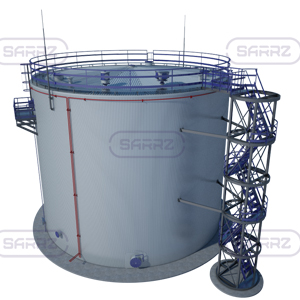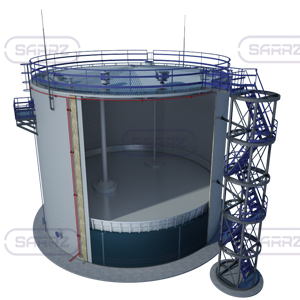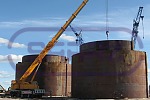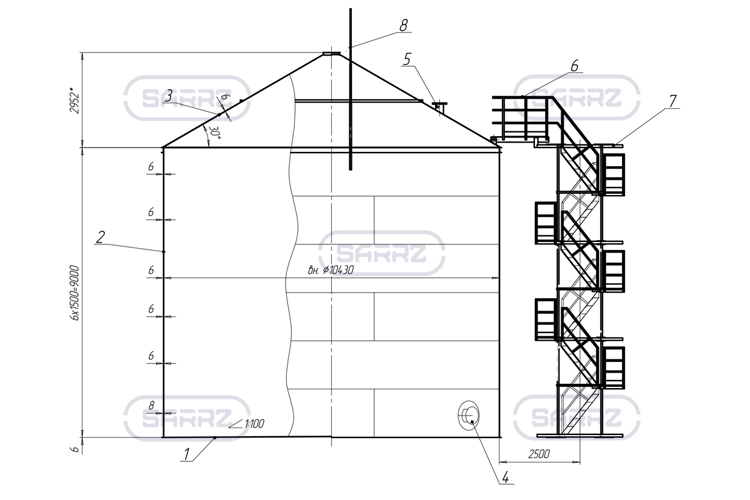Vertical tanks
|
Vertical steel tanks (VST)* are used for petroleum products, chemical liquids, food and other corrosive and non-intrusive environments storage. They are an essential element of the technological chain of many industries: petrochemical, food, gas, iron and steel, etc. They are most widely used in petrochemical industry, being a part of tank farms, crude oil loading terminals, oil producing and refining companies.
Tanks design, producing, erection, operation and maintenance are carried out in observance of the following:
- GOST 31385-2016 “Vertical cylindrical steel tanks for petroleum products. General technical specifications”;
- PB “Rules for design, fabrication and acceptance of steel welded vessels and devices”;
- STO-SA-03-002-2009 “Rules for design, fabrication and erection of vertical cylindrical steel tanks for petroleum products”;
- STO 0048-2005 “Vertical cylindrical steel tanks for bulk liquids. Rules for design”;
- VSN 141-80 “Guide on steel structures delivery by metalworks factories”;
- VSN 311-89 “Erection of steel vertical cylindrical tanks for petroleum products with capacity from 100 to 50000 m3”;
- RD 16.01-60.30.00-КТN-026-1-04 “Rules for design of steel vertical tanks with capacity from 100 to 50000 m3”;
As specified in them:
- fluid gravity should not be more than 1 t/m3
- storage under pressure 0.002 MPa, 0.069 MPa, vacuum 0.001 MPa or under pressureless conditions
Petroleum products tanks classification
Vertical tanks (VST) are vertical cylindrical vessels of different hight and diameter for storage of liquid up to 100000 m3.
Depending on field conditions and capacity, there are the following classes:
- I class – extremely dangerous tanks of more than 10,000 m3, tanks of more than 5000 m3, which are located within the city or down by the riverside
- II class - tanks of higher risk 5000-10000 m3
- III class - hazardous tanks up to 5000 m3
To comply with fire and environmental safety measures, the tanks must have a roof or pontoon to prevent flammable petroleum products evaporation and, accordingly, the entry of noxious substances into the environment.
According to the design and operating conditions, there are:
- tanks with a fixed roof, operating under an excess pressure of 0.002 MPa and a vacuum of 0.001 MPa
- tanks with a fixed roof, operating at a positive pressure of 0.069 MPa
- tanks with pontoon or floating roof, operating without pressure or vacuum
The Saratov Reservoir Plant produces vertical cylindrical tanks for petroleum products storage with a volume of up to 100,000 m3 with a pontoon, floating or fixed roof.
Oil tanks construction
They are vertical cylindrical tanks of different height and diameter for storing up to 100,000 m3 of bulk liquids. From above there is necessarily a roof (fixed or floating) or a pontoon, which are attached to the shell with a stiffener ring.
The choice of flooring type depends on Customer's requirements, field conditions and liquid properties.
Also, the tanks are equipped with main equipment (manholes, nozzles, etc.), stairs, caged platforms, etc.
 |
 |
Vertical tank scheme
1 -bottom, 2 - shell, 3 - roof, 4,5 - manholes, nozzles, 6 - caged platform, 7 - spiral staircase, 7 - electrical earthing, 9-ground lug
Fixed roofs
They are used to prevent air pollution from flammable vapors. There can be frameless and frame roofs. Frameless construction is used for small capacities - up to 5000 m3.
Each type can have two different geometric shapes: conical or spherical.
Frameless roof is a conical or spherical covering. Depending on the capacity there are the following types: conical frameless roofs that are installed at tanks up to 1000 m3, and spherical roofs - up to 5000 m3.
Frame roof is a constructional steelwork that is attached to the shell, and a covering that is freely set on the frame. They are also called blast relief structures. They have greater resistance to high dynamic loads and are used at a tank with capacity of more than 5000 m3.They are manufactured in explosion-proof design. They can perform the function of an emergency valve in case of pressure increase: instead of serious damage and deformation, the covering is torn off in the welded seam. The covering itself is not attached to the shell. Thus the integrity is insured.
Floating roofs
They are applied at a maximum snow load of not more than 1.5 kPa and are specially installed with the central part counterweight to be tilted to the center. It prevents the product from reaching the surface.
Floating roofs can be single-deck and two-deck. The single-deck design has operational limitations: they are installed on a shell with a diameter of up to 50 m with a maximum wind load of 100 km/h. Two-deck design is an enhanced version that has a greater floatability.
Pontoons
They are used in combination with fixed roof. Pontoon is a steel or aluminum rigid deck. It covers at least 90% of the surface and is necessarily gas-tight, which prevents the loss of the liquid.
Tank bottoms
The choice of bottom type depends on the tank capacity.
The tanks up to 1000 m3 are manufactured with flat bottoms. Their thickness is the same throughout the perimeter.
Larger tanks have cone bottoms, which may have an incline towards the center or from it. The most common in use is a conical base with an incline from the center as it helps to avoid bottom sludge deposits. The conical construction is made of a central part and annular plates of a thicker metal.
The summary table of technical characteristics
| Capacity, m3 | 50 | 100 | 200 | 300 | 400 | 500 | 700 | 1000 | 2000 | 3000 | 5000 | 10000 | 20000 | 30000 | 50000 | ||
|---|---|---|---|---|---|---|---|---|---|---|---|---|---|---|---|---|---|
| Inside diameter, mm | 3800 | 4730 | 6630 | 7580 | 8530 | 8530 | 10430 | 10430 | 15180 | 18980 | 22800 | 20920 | 34200 | 28500 | 39900 | 45600 | 60700 |
| Shell hight, mm | 4500 | 6000 | 6000 | 7500 | 7500 | 9000 | 9000 | 12000 | 12000 | 12000 | 12000 | 15000 | 12000 | 17880 | 18000 | 18000 | 18000 |
| The Shell | |||||||||||||||||
| The amount of rings, pcs. | 3 | 4 | 4 | 5 | 5 | 6 | 6 | 8 | 8 | 8 | 8 | 10 | 8 | 12 | 12 | 9 | 8 |
| Thickness of upper ring, mm | 5 | 5 | 5 | 5 | 5 | 5 | 5 | 5 | 5 | 6 | 6 | 7 | 8 | 8 | 12 | 12 | 11 |
| Thickness of lower ring, mm | 5 | 5 | 5 | 5 | 5 | 5 | 5 | 6 | 6 | 8 | 10 | 12 | 10 | 13 | 18 | 22 | 25 |
| The Bottom | |||||||||||||||||
| Thickness of the central part, mm | 5 | 5 | 5 | 5 | 5 | 5 | 5 | 5 | 5 | 5 | 5 | 5 | 5 | 5 | 5 | 6 | 8 |
| Thickness of edges, mm | - | - | - | - | - | - | - | - | 6 | 7 | 8 | 10 | 8 | 12 | 14 | 16 | 16 |
| The Roof | |||||||||||||||||
| Floorimg thickness, mm | 4 | 4 | 4 | 5 | 5 | 5 | 5 | 6 | 4 | 4 | 4 | 4 | 4 | 4 | 5 | 5 | 5 |
| Weight, kg | |||||||||||||||||
| Shell | 2183 | 3638 | 5094 | 7277 | 8187 | 9824 | 12007 | 16410 | 25581 | 36385 | 48426 | 62930 | 86450 | 126243 | 261122 | 299500 | 409480 |
| Bottom | 495 | 757 | 1467 | 1909 | 2409 | 2409 | 3582 | 3584 | 8205 | 12903 | 19052 | 17577 | 40756 | 33206 | 62606 | 102400 | 220649 |
| Roof | 529 | 767 | 1549 | 2715 | 2882 | 2882 | 4726 | 5379 | 12380 | 19350 | 31700 | 25340 | 78619 | 51611 | 110000 | 136200 | 325047 |
| Stairs | 350 | 950 | 950 | 950 | 950 | 950 | 1200 | 1200 | 1200 | 1200 | 1200 | 1200 | 1200 | 2300 | 5100 | 1830 | 20600 |
| Roof grounds | 633 | 788 | 1104 | 1263 | 1421 | 1421 | 1737 | 1737 | 2257 | 3159 | 3795 | 3483 | 5692 | 5600 | 6642 | 8500 | 10102 |
| Accessory equipment | 1072 | 1162 | 1162 | 1162 | 1442 | 1442 | 1772 | 1772 | 1772 | 1772 | 2512 | 4238 | 4631 | 4852 | 5294 | 5294 | 5294 |
| Manway plates and fitting pipes | 400 | 400 | 425 | 774 | 774 | 774 | 951 | 951 | 1077 | 1447 | 2460 | 2968 | 2986 | 2986 | 3561 | 6100 | 12384 |
| Frameworks and packing | 900 | 1100 | 1100 | 1100 | 1100 | 1300 | 1300 | 1700 | 3000 | 3400 | 5100 | 9600 | 10200 | 17550 | 24000 | 29600 | 52800 |
| Total | 6562 | 9562 | 12851 | 17150 | 19165 | 21002 | 27277 | 33433 | 55785 | 81359 | 113505 | 126792 | 230516 | 245835 | 477725 | 589424 | 1056356 |
Vertical tanks with protecting wall
They are a so called "glass in a glass". The oil or other bulk liquid is stored in the inner shell. The outer wall is necessary to prevent noxious substances from entering the soil or air in case of leakage.
The inner shell is made with a floating or fixed roof. The outer wall is a so-called "glass" of height not less than 80% of the main container height. If a weather skirt is provided, it is necessary to install ventilation of the interstitial space, the width of which must be at least 1.5 m. The bottom of the main tank can be in contact with the protecting bottom. In some cases, it is necessary to provide a free space between the bottoms, for example, for improved leakage control. Then the base of the inner vessel rests on the reinforcement mesh or lattice.
Manufacture of vertical cylindrical tanks
The Saratov Reservoir Plant produces vertical steel tanks VST in accordance with TU-5265-002-694784422013 and has the required Certificates of Conformity.
We produce tanks of any hazard class and design.
For the production, sheet steel of various types is used, depending on the chemical characteristics of the stored product and on the environmental conditions at the operation site:
- St3sp - for climatic zones with a minimum temperature of -40°C
- 09G2S - for climatic zones with an ambient temperature below -40°С
- 12H18N10T - for storage of food products, water or acids, it has high corrosion resistance
Metal structures of the tank can be manufactured in two ways: by rolling-up or plate-by-plate method. It is also possible to produce it by a combined method.
Vertical tank fabrication by rolling-up
This method provides shop fabrication of steel blank parts for the bottoms, shells and roof elements, their automatic or semi-automatic welding, and then erection at the construction site. Traditionally, tanks up to 5000 m3 have one roll, more than 10,000 m3 - four rolls.
At the construction site, rolls are unfolded: first, the roll of the shell is placed in a vertical position on the already unfolded bottom. Then it is deployed and fixed in the design position. Then the joints are welded and the covering is installed. The shell is connected with the bottom by double-layer welding of inside and outside welds.
From the outside, the surfaces can be covered with a heat-insulating layer - lagging of aluminum or zinc-coated steel sheets with a thickness of 0.9 and 0.7 mm, respectively.
This method is also used to produce small bottoms. In the production of large tanks, the peripheral part consists of individual elements that form a ring, and the lower ring is already attached to it.
Vertical tank fabrication by the plate-by-plate method
This method is comprised of individual sheets production of the required thickness and the maximum size of 2500x10000 mm. The edges are machined on endmilling machine or peripheral milling machine and edge milling machine. Then the steel sheets are transported to the construction site, where they are assembled into the finished construction.
The quality of the tanks is ensured by the following:
- edges are processed by planing or milling
- steel sheets should not have unevenness, burrs and blockages
- before welding, the surface must be mechanically cleaned off drosses, slug and other pollutions
- ultrasonic evaluation of welds for leaks
At the end of the tank erection, the primary tank calibration is carried out to determine its storage capacity.
Accuracy and compliance with the vertical tank design and manufacture standards contribute to their trouble-free and long-life use, leak tightness, reliability and safety.
At our Plant, both methods are use to produce vertical tanks.
How to order a production at the Saratov Reservoir Plant?
In order to enquire the cost of a vertical tank, you can:
- call at +7(8452)250-288
- send a filled in Questionnaire at an email
- use the "Request for quotation" form, provide contact details, and our specialist will contact you
The Saratov Reservoir Plant performs multiple services for the oil and gas facilities construction. We offer:
- engineering surveys at oil and gas facilities, including highly dangerous and technically challenging objects
- the design, project development and authority engineering approval of the oil and gas and chemical facilities construction
- vertical tanks, vessels, apparatus and other metal structures fabrication
- manufactured products delivery and installation in accordance with the tie-in design
*in Russia - Vertical tanks RVS

